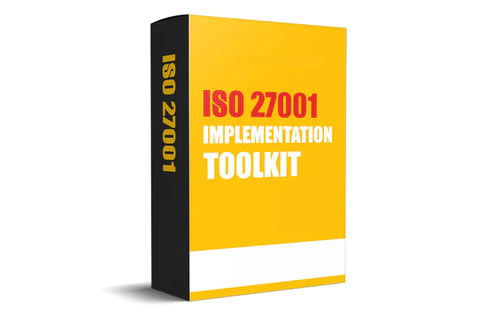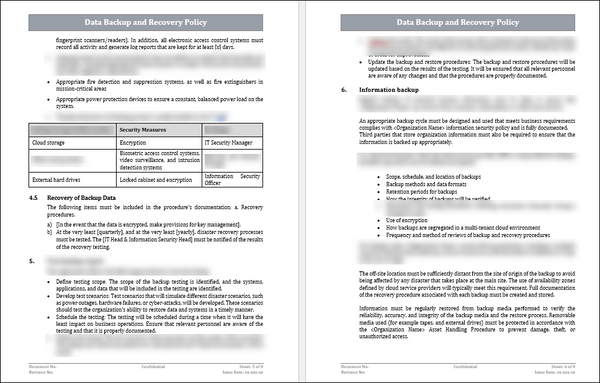ISO 27001:2022 Data Backup And Recovery Policy Template Download
ISO 27001, an internationally recognized standard, provides a framework to establish, implement, maintain, and continuously improve an Information Security Management System. Data Backup and Recovery Policy is a critical part of the ISMS. It focuses on the integrity, availability and recoverability data in case of an unexpected loss or disruption.ISO 27001's Data Backup and Recovery Policy outlines procedures and guidelines to create and maintain secure and reliable backups for critical data assets. The ISO 27001 Data Backup and Recovery Policy defines processes to restore data in the event of data loss, corruption or accidental deletion.
Why you Should Have a Data Backup and Recovery Policy
ISO 27001 requires a policy for data backup and recovery. This is important because it contributes to an organization's information security and continuity.
- Data Integrity and Protection: The policy ensures the regular backup of critical data, protecting it from accidental deletion, failures in hardware, data corruption or cyberattacks. Regular backups minimize the risk of permanent loss of data by protecting the integrity of the data.
- Business Continuity and Disaster Recovery: A data backup and restoration policy is a critical part of a business continuity and disaster relief plan. In the event of a data loss or disruption, reliable backups enable the organization to quickly restore its operations. This minimizes downtime and reduces the impact on the business processes.
- Data Loss Prevention: The loss of vital data can cause severe financial and brand damage to an organisation. A data backup policy is a safety net that protects against significant data loss.
- Rapid Recovery after Incidents: If a cyber-attack or data breach occurs, it is important to recover data quickly in order to minimize the impact on the business and return normal operations. The policy streamlines recovery, reducing time and effort to regain control.
- Protection against Human Errors : Accidental deletion or modification of data by employees can result in significant data loss. Data backups are a great way to mitigate the impact of human error.
- Data Recovery Testing: This policy encourages testing and validating data backups regularly to ensure that they are working correctly and can be restored successfully when needed.
Test and Implement Your Data Backup Plan
ISO 27001 requires a systematic approach for implementing and testing data backup and restoration plans to ensure data are adequately protected and recoverable if data are lost or disrupted.
- Data Backup: Describe the process for creating regular backups, which ensure that critical data and system are protected and restored in the event of a disruption.
- Data Backup Selection: Define the criteria to select which data needs to be backed up. Consider factors such as data importance, critical systems and regulatory requirements.
- Explain the types of backups that are used: Include full backups as well as incremental and differential backups. Define the appropriateness of each type.
- Backup Storage and Facility: Identify where the backup data will reside, such as on-premises in a datacenter or cloud. Security of backup storage should be addressed both physically and logically.
- Recovery of Backup Data: Describe the steps to be taken in order to retrieve and restore backup data if necessary. Include information about the process of restoration, validation and verification.
- Test backup copies: Stress the importance of testing backup copies regularly to ensure their integrity, and the successful recovery of data.
- Information Backup: Include critical information, such as configuration settings and encryption keys in the backup process.
- Storage Management: Explain the procedures to manage storage space, ensure adequate capacity and regularly purge outdated backups.
Train Employees in Data Backup and Recovery Procedures
It is important to train employees in ISO 27001 data backup and recovery procedures. This will ensure they are aware of their roles in maintaining data integrity, and can effectively execute recovery tasks.Here is a guide to conducting training for your employees.
- Assess Training Needs: Start by assessing training requirements for employees who are involved in the data backup and recovery process. Identify specific departments and roles that are responsible for data backup and customize the training.
- Training material :create training material that is tailored to the roles and responsibilities of employees. Cover the basics of backup and recovery including data classifications, backup frequency and policies, as well as recovery procedures.
- Data Backup and Recover Concepts: Educate your employees about the concepts behind data backup and recovery. This includes RTOs and RPOs, different types of backup (full-, incremental-, differential-), and various backup media (locale, cloud-based or off-site).
- Step-by-step instructions for performing data backups: Demonstrate the proper way to choose backup media, start backup processes and verify backup integrity.
- Data Recovery Procedures: Describe the process of data recovery in detail. Employees should be trained on how to restore files and access backup data.
- Role-Specific training: Tailor the training to different job roles that are involved in data recovery and backup. System administrators may receive training on setting up backup schedules while end users might learn how recover files from backups.
- Backup operations : monitor backup operations and create reports to identify failures and anomalies. They should be instructed on how to respond when problems are detected.
Conclusion
Training employees in ISO 27001 data backup and recovery is crucial for maintaining an organization's security posture and establishing a robust strategy to protect data. Employees are equipped with the skills and knowledge needed to backup data, verify its integrity and recover data effectively by providing them with comprehensive, role-specific training.A well-designed program will cover the basic concepts of data recovery and backup, such as data classification, backup frequency and retention policies. It emphasizes that ISO 27001 and best security practices are essential to protecting sensitive information.





